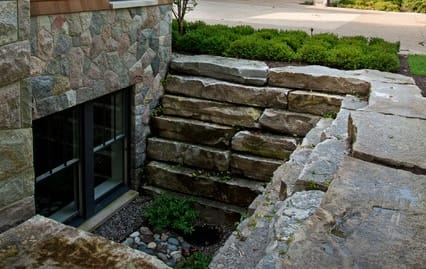Window Wells: Design, Function, and Maintenance Every Homeowner Should Know
Window wells bring light, ventilation, and safe egress to basements—but only if properly designed and maintained. Learn how NYS code governs their use, how drywells and covers protect your home, and what seasonal maintenance every homeowner should perform.

Basements often add valuable living space to a home, but they also present unique challenges. One of the most important yet overlooked details is the window well. When designed and maintained properly, a window well allows light, ventilation, and safe egress while protecting your basement from water intrusion. When ignored, however, it can quickly become a source of leaks, dampness, and costly repairs.
What Is a Window Well?
A window well is the excavation and retaining structure built around a basement window that sits below grade. Typically formed with steel, concrete, or modular plastic, a window well holds back soil, prevents collapse, and creates an open cavity in front of the window.
The functions of a window well are threefold:
- Light and Ventilation: Window wells allow natural light and fresh air into basement rooms that would otherwise be dark and stagnant.
Reference: RCNYS Section R303 – All habitable basements must be provided with natural light and ventilation, either by windows or mechanical means. - Egress: For finished basements, code requires that at least one window meet the standards for emergency escape and rescue openings. This means the window must be large enough to allow occupants to exit and firefighters to enter.
Reference: RCNYS Section R310 – Egress windows must have a minimum clear opening of 5.7 sq. ft. (5.0 sq. ft. at grade), a minimum opening height of 24", a width of 20", and wells deeper than 44" require a ladder or steps. - Drainage: Because window wells sit below grade, drainage is essential. Most wells include a drain at the bottom that connects to a drywell or to the home’s perimeter foundation drain.
Reference: RCNYS Section R405 – Foundation drainage is required where groundwater or soil conditions warrant, including proper window well drains to prevent accumulation.
The Role of Drywells and Covers
At the base of most window wells is a drain, and this drain must go somewhere. There are a few common approaches:
- Stone-filled drywell: A pit filled with clean gravel or stone that allows water to percolate naturally into the soil.
- Container-style drywell: A manufactured barrel or chamber with perforations, typically installed with a stone base to disperse water slowly into surrounding soils.
- Connection to footing drains: In many modern homes, the window well drain ties directly into the foundation’s French drain system, carrying water to a sump pump or to daylight discharge.
Window well covers are equally important. They prevent debris like leaves, sticks, and trash from falling into the well and clogging the drain, while also reducing direct rainwater entry. They add safety by preventing accidental falls. Polycarbonate covers are most common, since they let light pass through while shedding water, but steel grates are sometimes used when ventilation is prioritized over weather protection.
Maintenance Homeowners Should Perform
Even a well-constructed window well requires regular upkeep. Without it, drains clog, water backs up, and the system fails. At a minimum, homeowners should plan the following seasonal tasks:
- Remove debris: Clear out leaves, sticks, and sediment that collect in the well and around the drywell. These materials block drainage and create standing water.
- Check the cover: Inspect the fit and condition of the cover. Replace cracked or warped covers to keep water and debris out.
- Test drainage: During a rainstorm or with a bucket of water, confirm that water drains quickly into the drywell rather than pooling.
- Refresh the gravel: Over time, fines and silt clog the stone layer in the drywell. Replace or replenish the gravel every few years.
Common Problems and Solutions
Homeowners often encounter similar issues with window wells. Knowing the causes and remedies can prevent small problems from becoming major ones:
- Standing water: Usually caused by a clogged drywell or blocked connection to the footing drain. Cleaning and adding new washed stone often resolves it. In severe cases, re-routing to a sump pump is necessary.
- Leaks around the window: Ensure the window is properly flashed and sealed. If water bypasses the drain, it may be forcing itself into the frame.
- Improperly sized well: If the well is too shallow or too small, it may not meet egress requirements. Replacement with a code-compliant unit is necessary for finished basements.
- Unprotected wells: Wells without covers fill quickly with debris, snow, and even pests. Adding a durable cover is a low-cost upgrade.
Why Maintenance Matters
Water is one of the most destructive forces against a home’s foundation. A clogged or neglected window well creates a direct path for water into your basement. Beyond moisture damage, non-compliant wells also compromise life safety by blocking or reducing usable egress.
By spending a few minutes each season cleaning, checking drainage, and maintaining covers, you not only protect your basement from leaks but also preserve the safety and functionality of your living space. Window wells are small features, but when ignored, they can create very large problems.
